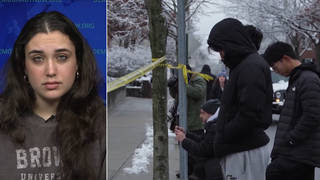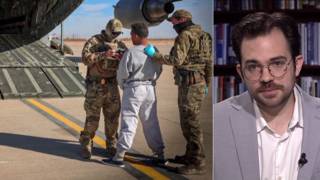
Topics
Guests
- Joshua DenbeauxSenior Research Fellow at the Seton Hall Law Center for Policy and Research.
- Shana Edwardsfinal-year law student and a fellow at the Seton Hall Law Center for Policy and Research.
A report by twenty-seven students and graduate research fellows from the New Jersey-based Seton Hall University School of Law reveals that the US government routinely videotaped the 24,000 interrogations conducted in Guantanamo Bay between 2002 and 2005. The Pentagon denies the charges. We speak to two of the report’s co-authors. [includes rush transcript]
Transcript
AMY GOODMAN: New evidence reveals the US government routinely videotaped the 24,000 interrogations conducted at Guantanamo between 2002 and 2005. The report released Thursday by professors and students from the New Jersey-based Seton Hall University School of Law cites internal reports from 2005 by Army Surgeon General Kevin Kiley and Lieutenant General Randall Schmidt.
The two CIA tapes that were destroyed might just have been a fraction of the thousands of recorded interrogations, this according to the legal researchers, who say cameras are positioned in every interrogation room. But Guantanamo spokesperson Rick Haupt denied the charges. He told Agence France-Presse Friday that ”JTF (Joint Task Force) Guantanamo is not required to videotape interrogations and did not routinely do so.” He added, “That said, we always monitor interrogations, in accordance with DOD (Department of Defense) directives for the purpose of interrogation oversight and to ensure safe and humane treatment of detainees.”
The Seton Hall University report is called “Captured on Tape: Interrogation and Videotaping of Detainees in Guantanamo.” It was compiled by twenty-seven student and graduate research fellows at the Seton Hall Law Center for Policy and Research.
We’re joined now by two of the report’s co-authors: Joshua Denbeaux, senior research fellow at the Center; and Shana Edwards is a final-year law student and a fellow at the Center.
We welcome you both to Democracy Now!
JOSHUA DENBEAUX: Thank you.
AMY GOODMAN: Joshua Denbeaux, let’s begin with you. What did you find?
JOSHUA DENBEAUX: Well, we found that the Surgeon General of the Army, in response to concerns from the AMA as to the involvement by medical professionals with interrogations, had to answer the question: what was the association between medical professionals and interrogations? And he came up with a response, and the response was: medical professionals weren’t in the room when the interrogations were going on; we watched the videotapes, and everything was videotaped — which quite neatly answers his question, answers the problem that was faced by him as a physician, which is, why are you involved in the interrogations? It’s not appropriate. And then, of course, if the medical professionals are not involved in the interrogations, the next question is, well, why not? Why isn’t there a medical professional involved in the interrogation? And so, his report concludes we simply weren’t involved in the interrogations, but we monitored everything by watching the videotape afterwards.
AMY GOODMAN: Where did you see this?
JOSHUA DENBEAUX: In General Kiley’s report in 2005, which we were only able to find because we have so many amazingly dedicated students, including Shana.
AMY GOODMAN: Shana Edwards, talk about — I mean, the leadership at Guantanamo is saying this isn’t true.
SHANA EDWARDS: Well, I think the rationale from an intelligence gathering standpoint is we would hope that they’re videotaping these interrogations. Obviously, videotaping is a very effective method of capturing an interrogation. It allows those who are trying to gather intelligence to review the tape for body language, question-and-answer sessions. And I think also it goes back to what General Kiley’s rationale was for saying that they were videotaped, which is it protects our interrogators from any allegations of wrongdoing, and it’s a very effective check against any violations of the law of war. I think that — from a policy standpoint, I think that it makes complete sense that they are videotaping, and I think that we’ve found evidence that they are.
AMY GOODMAN: And what do you make of Guantanamo spokesperson Rick Haupt denying the charges, saying, “[Joint Task Force] Guantanamo is not required to videotape interrogations and did not routinely do so”?
SHANA EDWARDS: I would ask him why — what is his rationale for not routinely doing so? Is there — what is his explanation for not video recording what is supposed to be — which is alleged to be a very valuable human intelligence gathering? I would want to know how he would respond to that.
AMY GOODMAN: Joshua Denbeaux, talk about the places where you found the references to the videotaping of, what, 24,000 interrogations.
JOSHUA DENBEAUX: Well, there’s a lot of references of videotaping. I think you’re specifically referencing General Kiley’s report. Now, he was the Surgeon General of the Army. He says everything was videotaped. General Randall Schmidt issued a report in which, as of 2005, he said there were 24,000 interrogations. Now, the math isn’t too hard. If everything is videotaped, according to one general, and another general says there’s 24,000 interrogations, there’s 24,000 videotaped interrogations, unless, of course, one, two or every general in the United States military involved in this is completely wrong.
And I think the question you asked Shana is one that begs the question. You know, one general says, “Now, wait a second, we didn’t routinely videotape everything.” So the question isn’t “why didn’t you?” — maybe that is a question, but a better question is, what do you have to say about General Kiley? Why did he write that?
AMY GOODMAN: Where do you think these videotapes are?
JOSHUA DENBEAUX: I haven’t the foggiest clue.
AMY GOODMAN: Shana, thought about it?
SHANA EDWARDS: Absolutely. I mean, I wish that I knew. It’s one of the many mysteries of Guantanamo. I think that as we’ve worked over the past three years, the more you dig, the more complicated it becomes.
AMY GOODMAN: And your thoughts about the uproar over the discussion of the destruction of the videotapes? Even in that case, do you think there are backup videotapes?
SHANA EDWARDS: I couldn’t speculate. I really couldn’t speculate.
AMY GOODMAN: Have you requested to know from the government where these videotapes are?
JOSHUA DENBEAUX: Well, first, there is — General Kiley says there’s videotapes. Other generals say there aren’t. Let’s not jump to conclusions and say definitively there are videotapes. There are at least some videotapes, and maybe everything was videotaped. I represent two of the prisoners, and we’ve asked the judge to catalog — make the government catalog the existence of all the videotapes, so we’ll have an answer to that question. But until the government does that, and until the government answers this question — why did General Kiley write a report that says everything was videotaped? — until they can answer that question, we really can’t tell who or what was videotaped.
But I’d like to leave one question, and that is, if you had 24,000 interrogations of people who you say were a danger to the United States and very important to interrogate, how would you organize all that data?
AMY GOODMAN: You are a student — and we have to end here, Shana Edwards —
SHANA EDWARDS: Yes.
AMY GOODMAN: It took you and your fellow and sister students discovering this?
SHANA EDWARDS: Yes, absolutely, and I think that’s been a pattern. There are, you know, numerous volumes of documents that have been released by the government, and we just take them at their word. You know, we don’t come at this with any sort of bias. We look and take what the government is telling us at face value and see what that reveals. And I think that, you know, it’s an important task for us as we go ahead.
AMY GOODMAN: I want to thank you both for being with us, Shana Edwards and Joshua Denbeaux, both of Seton Hall Law School. We will link to their report at democracynow.org.













Media Options